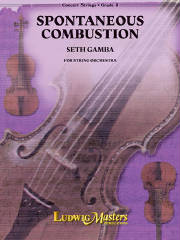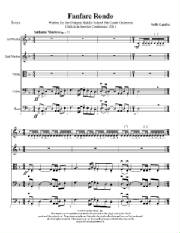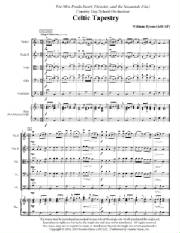|
|
To order school music and pay by check please fill out an order form and you will receive
an invoice.
Order Form
Join our mailing list
Shipping & Handling Charges |
|
|
S&H fee
|
|
|
|
|
|
|
|
|
|
|
$100.00 - $249.99
|
|
|
$250 and up
|
$17.00
|
|
|
School Music
If selections do not play automatically, right-click and save file to your computer.
|
|
Rhythmic
Projections Rhythm Exercises for Building Mastery by Seth Gamba Rhythm is the most important thing in music. Most methods for teaching rhythm
to students present a concept, give it a couple of lines, and then move on to something new. Most students learn those
lines by memorizing them without really understanding the rhythmic concept that’s being presented. Rhythmic
Projections is a set of exercises designed to give students the varied repetition they need to understand and internalize
a rhythmic concept without being able to memorize it. With over 100 pages of examples, there’s just too much to
memorize. Students have to learn how to read! Features
of Rhythmic Projections: - Step by step introduction of concepts going from very easy to highly advanced
- Over 400 exercises that
fully explore each rhythmic concept
- Exercises are not intended to be used strictly in order – each section
begins at the easy level of its concept and then moves to more difficult exercises. For example, you may start 16th note
or 12/8 exercises without having done the 1/8 note syncopation exercises.
- Sustained and syncopated rhythms are always
presented with their tied and rested equivalents so students can easily see how different rhythms are proportional or similar
to each other.
- Rhythm-only format is perfect for any combination of instruments or voices. Different clefs or transpositions?
No problem!
- Projected format means no student books to pass out, take up, keep organized, or lose.
- Use a
laser pointer to make sure everyone is in the same place at the same time. Take away the pointer to help students move from
guided practice to independence.
- Use the rhythm exercises to give writing assignments to your students. Language
Arts teachers know that to be a good reader, you have to be a good writer. Music is no different! Students can copy rhythms
using the notes of any scale and write in their counting. This lets you quickly identify individuals who are having trouble
understanding concepts and reinforces all aspects of their reading development.
- Use rhythm exercises to introduce
composition. Students choose their own notes to go with the rhythm and play it for their classmates or teacher.
- Includes
blank templates for Finale and Sibelius so you can create your own rhythm exercises to go with particular repertoire or for
quizzes.
Now Available from Ludwig Masters Publications! |
| |
|
|
Available from Ludwig Masters Publications
|
|
Rock On! (Level 1) by Seth Gamba
This is a hard rockin' number for beginning strings!
Rock On! is great for teaching the notes on the G string and features easy, driving rhythms that your students will
love. Drumset is required, but I do not recommend a student drummer. If a good drummer is not available, use the
mp3 or MIDI play-along files found here.
Rock On! was premiered at the 2008 Upbeat! Summer Orchestra
Camp with the 4th and 5th grade Orchestra. |
|
Listen to Rock On!
|
Drum Part - MP3
|
Drum Part - MIDI
|
|
|
|
|
|
|
Mountain Dance (Level 1)
by Seth Gamba Mountain Dance is a fun piece perfectly suited
to first year Orchestra students. Mountain Dance only uses the notes from a one octave D scale.
It also features a limited rhythmic palette with a few recurring patterns of 1/4 notes, 1/4 rests, and 1/8 notes, but
the patterns get mixed up enough so that the students actually have to read the music to get them!
Listen to Mountain Dance
|
|
|
C Here (Level 3)
One of the main learning goals in middle-school orchestra is the ability for students to play
using many different finger patterns. One of the first finger pattern changes that students learn is to move from a
high-two pattern to a low-two pattern. When done on the A string this gives students a C-natural instead of a C-sharp.
C Here focuses on these two finger patterns and constantly moves between them using the high-pattern on the D string
and the low-two pattern on the A string. The title comes from an experience that is very familiar to all orchestra teachers
when teaching these two patterns. That is, when students begin learning the low-two pattern, we must constantly remind
our students that they must put their ‘C here’! This piece should not be used to introduce the low-two pattern,
but it is fantastic for consolidating and reinforcing that skill down the road.
The piece uses the rhythmic pattern
of a Brazilian dance called the Baion to frame this skill in a fun way and to help students use these two patterns in more
complex and interesting ways than when they first learned them. C Here was composed during the summer of 2006
and received its premier at that year’s Upbeat! Summer Orchestra Camp. It was also performed at the 2008 GMEA
convention in Savannah, GA.
Listen to C Here
Now on the GMEA LGPE list for level 3!
|
|
|
Storm Surge (Level 3) by Seth Gamba
A
musical adventure on the high seas! An energetic piece in D minor, Storm was performed at the
2007 GMEA convention in Savannah. Storm features melodies and harmonies that are perfect for reinforcing
the switch from high to low first finger that can be so challenging for young Orchestra students. It is
also a great vehicle for introducing the harmonic minor scale. Storm has melodic parts for all
instruments as well as extended sections of repeated 1/8 notes that are intended for introducing and refining brushed bow
strokes.
Listen to Storm
Now on the GMEA LGPE list for level 3!
|
|
|
Get
ready to burn up the concert hall with Spontaneous Combustion! Written for the Elkins Pointe Middle School
Orchestra and premiered at the 2010 GA Music Educator's Conference, this piece features scorching rock melodies with power
chord accompaniments and a reggae interlude worthy of Bob Marley himself. Set
in G Dorian, Spontaneous Combustion features challenging parts for every section. It is a great vehicle for
teaching the syncopated rhythms that are so common in pop and other modern music. Students must use low 1st
fingers and some 3rd position in the 1st violin part. Drumset
is required. If a good drummer is not available, use the mp3 or MIDI play-along files found here. |
|
|
Listen to Spontaneous Combustion
|
Drum Part - MP3
|
Drum Part - midi
|
| |
Now available from Ludwig Masters Publications!
|
Music by Seth Gamba
|
|
Into the Lion's Den (Level 3)
by Seth Gamba Starting with
a haunting g-minor melody, the violas and cellos contemplate entering the Lion's Den. After the slow introduction, the
pace quickens to a fast 6/8 that has fun and challenging parts for all sections! Into the Lion's Den was commissioned by the Autrey Mill MS Orchestra and premiered at the 2012 GMEA
conference in Savannah, GA.
Listen to Into the Lion's Den
Price: $40.00
|
|
|
Fanfare Rondo (Level 4) First heralded by the low strings, this energetic fanfare calls up images of warriors preparing for battle.
The style should be kept crisp and slightly aggressive. The episodes of the rondo bring up images of a heroic sendoff,
a battle, and a requiem telling the story of a nation embroiled in war.
Fanfare Rondo was
commissioned by the Dodgen MS Orchestra and premiered at the 2011 GMEA conference in Savannah, GA. |
|
Listen to Fanfare Rondo
|
|
|
|
Price: $40.00
|
|
|
Music by Tim Aucoin
|
|
La Flor De Baile (The Flower of Dance) (Level 2)
by Tim Aucoin
This fun latin tune
for string orchestra, piano, and bongo hints of a lovely spring festival in Old Mexico. The tune begins with a Spanish
flavored rhythm that leads to a pretty, syncopated melody. The composition features homogeneous bowings in the upper
strings and similar figures throughout in the bass and cello. The piece alternates between G Major and E minor.
No parts go beyond 1st position, although violin I is required to play low 1 ‘D#.' La Flor De Baile is
a great introduction to alternative styles or for international programs for developing groups. Enjoy the trip South
of the Border with this very playable piece.
Listen to La Flor de Baile
Price: $40.00
|
|
|
Big Chicken Mambo (Level 3)
by Tim Aucoin
This exciting
latin tune for string orchestra and rhythm section is named for a famous Marietta, Georgia landmark near Dickerson Middle
School - a giant chicken structure that houses a fried chicken restaurant. The tune begins with a short, pretty violin
solo with piano accompaniment and then explodes into a mambo groove. Big Chicken features fun melodies in all parts
and an authentic montuno in the piano part to go along with the driving drumset. The
Big Chicken Mambo is a great alternative styles tune for intermediate groups. The piece is in G Major and no
parts go beyond 1st position. It is a bit rhythmically challenging, but a lot of excitement is packed into this very
playable tune. The middle of the tune also features space for a drum solo with an opportunity to let students get creative
with percussion instruments before returning to the melody. Have fun, but wipe the grease from your fingers when you're
finished!
Listen to Big Chicken Mambo
Price: $40.00
|
|
|
Rio Breezes (Level 4.5)
by Tim Aucoin
This beautiful samba for string orchestra and rhythm section is reminiscent
of the warm breezes that waft across Ipanema Beach in Rio de Janeiro. The tune begins with a soothing samba
groove that gives way to an infectious melody. There is ample opportunity to work on phrasing and elevated
musicality. Rio Breezes features challenging rhythms in all parts and is a great platform for
teaching 16th note subdivisions. This is a great alternative styles tune for medium to medium/advanced
groups. The piece is in D minor and most parts stay within 3rd position. At the end
of the tune there are few spots where the violins have ‘E6,’ but it is doubled 8vb. Enjoy the
Carnival anytime of year with Rio Breezes.
Listen to Rio Breezes
Price: $40.00
|
Music by Richard Bell
|
|
Three Early Baroque Dances (Level 3.5) by Richard Bell
This
three movement suite (La Forlana, Well Hall and Sellenger's Round) is based on European dance tunes from the late 16th
and very early 17th century. The arrangement strives to maintain an early baroque folk dance quality in both the rhythmic
and harmonic structure. This charming set would be great for older middle school or younger high school orchestras.
|
|
Listen to 1. La Florana
|
Listen to 2. Well Hall
|
Listen to 3. Sellenger's Round
|
|
Price: $40.00
|
|
|
|
|
Betelehemu (Level 3.5)
by Richard
Bell This is an energetic arrangement
of the Nigerian Christmas song in key of C. Scored for strings and percussion, it will add a unique African flavor to your
holiday concerts. The percussion parts are fairly simple and may be played by members of your orchestra.
Listen to Betelehemu
Price: $40.00
|
|
|
Concerto Grosso on American Themes for 2 Violins, Viola and String Orchestra (Level 4)
by Richard Bell
This three movement work utilizes American folk songs and hymn tunes for
its melodic material. It is an excellent outlet to feature several of your players in solo settings. Viola may be substituted
for the violin 2 solo part and cello may be substituted for the viola solo part to give you even more possibilities to feature
soloists. |
|
Listen to Concerto Grosso Mvmt 1
|
Listen to Concerto Grosso Mvmt 2
|
Listen to Concerto Grosso Mvmt 3
|
|
Price: $40.00
|
|
|
|
|
Incorporating
several bluegrass tunes, this exciting work would be a great closer for any concert. The work combines the classical sonata
form with a bluegrass style. There are interesting parts for everyone - up to 3rd position for all instruments.
Listen to Encore!
|
|
Price: $40.00
|
|
|
May Your Mourning Turn to Dancing
(Level 4)
by Richard Bell
You have turned my mourning into dancing; you have taken off my sackcloth and
clothed me with joy. This quote describes the work - a slow mournful section followed by a lively dance in rondo form.
The opening features solos for viola and cello. The A section of the dance is highly syncopated while the B section is a 4
part fugue. The C section is a waltz using material from the opening. A musically meaty yet playable work for your string
orchestra.
Listen to May Your Mourning
Price: $40.00
|
Music by William Dyson
|
|
Alabama Dream (Level 3)
by William Dyson
In 2006, Dr. David Satcher retired from his post of Director of
the National Center for Primary Care at the Morehouse School of Medicine in Atlanta, Georgia. Prior to this, Dr. Satcher had
served as the sixteenth Surgeon General of the United States under presidents Bill Clinton and George W. Bush. At his retirement
ceremony, the staff, faculty, and students of Morehouse School of Medicine wanted to give Dr. Satcher a unique retirement
gift. It was recommended that a string quartet selection be composed that reflected the background and interests of Dr. Satcher. Dr. Satcher is a native of Anniston, Alabama, and he loves all types of music, especially classical
and jazz. The composition, ALABAMA DREAM, was to have elements of classical music and jazz. A blues type shuffle was created
as the overall arch of the composition, with classical music elements interspersed. In tribute to Dr. Satcher's origin, the
state song of Alabama was also incorporated in the composition. Originally written for string quartet, this version has been
expanded to string orchestra. It is well suited for advanced middle school and high school string orchestras.
Listen to Alabama Dream
Price: $40.00
|
|
|
Celtic Tapestry (Level 3) by William Dyson
Celtic Tapestry was written for the Savannah (Georgia) Country Day
School orchestras. Savannah has a rich heritage of Irish tradition, as it was the port through which many of the Irish passed
as they immigrated to America. For this reason, traditional Irish tunes were selected as the basis for Celtic Tapestry. The composition begins and ends with the traditional jig, "Dingle Regatta".
It also includes the traditional Irish tunes "She Moved Through the Fair" - which is both a love story and a ghost
story - "The Hag with the Money" - a jig that has been played for hundreds of years - and "(Down By) The Salley
Gardens" - a setting of a poem by William Butler Yeats. |
|
Listen to Celtic Tapestry
Price: $40.00
|
|
|
|
|
The Epic of Gilgamesh (Level 3) by William Dyson
The Epic of Gilgamesh tells the story, in music, of the first legendary literary hero.
This epic pre-dates both The Iliad and The Odyssey by several centuries. Gilgamesh
is the model for both of these later epics. This music for string orchestra is the result of a grant from the Georgia Middle
School Association. The
Epic of Gilgamesh consists of five movements. Click on the movement titles below to listen. |
|
1. The City
|
2. The Cedar Forest
|
3. The Quest
|
4. The Flood
|
5. Return to the City
|
|
Price: $40.00
|
Other Products
|
|
Produced and engineered by Seth Gamba, Magnify His Name was completely
recorded at Gamba Music Studios. With texts from the sacred writings of the Baha'i Faith, this album magnifies His
name with energetic, original music influenced by R&B, Blues, Gospel, & Jazz. The NWUE is the choir at the Baha'i
Unity Center in Decatur, GA.
|
|



















